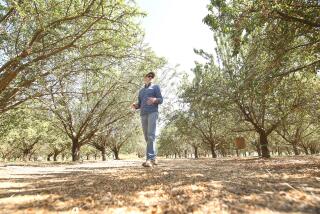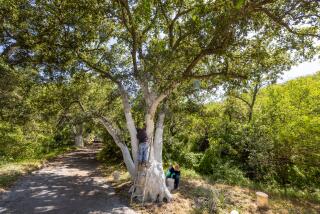Gypsy Moths Ravage Wood Industry : Environment: The insect has invaded at least 17 states and has defoliated millions of acres across the nation since 1889.
- Share via
HOPEWELL, Pa. — A tiny caterpillar massing by the millions, perhaps billions, is devastating Eastern forest lands, eating lumber mills out of business.
Clair Dodson and his three brothers are among the bug’s latest victims.
Nearly 3,000 wooded acres owned by the Dodsons and another 2,000 managed by them in the Appalachian Mountains near this south-central Pennsylvania hamlet are being munched to death by gypsy moths. After 47 years of harvesting and milling majestic red, chestnut and white oak, Dodson Bros. Lumber Co. went out of business in April and was sold piecemeal at auction.
Gone were the skidder, debarker, huge saw, chipper and milling machines that provided the Dodsons’ livelihood for so many years.
“The gypsy moth has pretty well decimated the timber I have,” says Darrel Dodson, 51.
The onslaught was so dense that gypsy moth droppings sounded like rainfall.
“In the spring, get a breeze, it looked like someone dropping pepper,” says Clair Dodson, 62. “They’ll float for miles and miles.”
More than 200 people from as far away as Iowa slogged through the mud of Groundhog Valley in the shadow of Harbor Mountain on a cold, rainy day to bid on 331 pieces of the company.
With Clair and Darrel and brothers Veryl, 64, and Lewis, 60, 19 people lost their jobs with the sale, including Clair’s son. The end came at the end of April, the same time new moths began to hatch for another feeding season.
About 30 miles to the south, in central Bedford County, the story is much the same, but a decade removed, for the M.C. Houseworth Lumber Co.
Houseworth has about the same number of employees as Dodson Bros. but with three times the timber holdings. It has spent nearly $250,000 in the past eight years to protect 4,000 acres of mostly oak and some maple, walnut and poplar on Evitts Mountain, owner and President David Fisher says.
Its remaining 11,000 acres, not yet mature and not worth the expense of spraying, have been left for the moths, he says.
Fisher says spraying has bought his company about 10 years of operations.
But by 2001, Fisher expects Houseworth, too, will be going out of business.
“In Bedford County, in a couple of years, there won’t be any timber,” he says.
The gypsy moth is considered the most serious insect threat to Pennsylvania’s forests, according to the state Bureau of Forestry’s Division of Forest Pest Management.
A native of Europe, Asia and North Africa, the brown or white insect was introduced into Massachusetts from Europe in 1869 by French scientist Etienne Leopold Trouvelot. He was hoping to produce a new race of silk-producing insects, resistant to diseases that had swept Europe and nearly decimated the silk industry.
Some of the insects escaped. A menace was unleashed.
The gypsy moth particularly likes oak. It spread from the New England states and has been moving southwesterly across Pennsylvania for the last decade. The gypsy moth is firmly established as far west as Michigan, through Ohio and West Virginia and as far south as the northern parts of North Carolina, says Doug Hendrix, a Department of Agriculture spokesman in Washington.
“They can spread about 15 to 30 miles a year, aided by wind primarily,” he says. “And they also tend to hitch rides on vehicles.”
All told, the gypsy moth has invaded at least 17 states, none harder hit than Massachusetts, says Jim MacArthur, bureau chief of Shade Tree Management and Pest Control for the Massachusetts Department of Environmental Management.
Millions of acres nationwide have been defoliated since the first general gypsy moth outbreak in Medford, Mass., in 1889, Carnegie Magazine reported. About 7.5 million acres were defoliated nationwide in 1990 alone.
Accurate estimates of the monetary damage gypsy moths have wrought are not available, Hendrix says. That would take a tree-by-tree inventory, with a specific price attached to each tree--a virtually impossible task, officials say.
The U.S. Forest Service fights the largest infestations nationwide. Since 1979, it has spent an average of $6.1 million a year to fight the moth, says Ken Knauer, the agency’s assistant director of forest pest management.
For the fiscal year that ended in September, 1990, the Forest Service spent $13.6 million.
Fighting the gypsy moth in Pennsylvania has been a hit-and-miss affair, says Barry Towers, chief of the state’s Division of Forest Pest Management.
“There are 18 million acres of forest land out there. Probably half of that is oak,” he says. “There’s no way we could spray that many acres. We just don’t have that many people.”
But people like the Dodsons are the big losers.
The Dodsons’ father began the lumber company in 1944 to escape the coal mines. Having spent more than 30 years underground, Chester Dodson’s health was impaired by black lung disease. He saw gold in the region’s vast oak stands, left to prosper when a blight wiped out competing chestnuts in the early part of the century. And land was relatively cheap.
Those were the days when timber stands on the mountains overlooking the Raystown Branch of the Juniata River could be bought for $20 to $25 per thousand board feet. Now, prices are $150 to $250 for the same amount, Darrel Dodson says.
Dodson Bros. cut and processed 2.5 million to 3 million board feet a year in its better years in 1987 and 1988.
Much of the timber was cut into railroad ties, some was made into furniture. The scraps were made into paper.
Oak grew nearly exclusively after the chestnut blight and for the next 50 years, making a nearly one-species forest especially susceptible to gypsy moths. In the 1970s, state and private forestry experts warned the Dodsons and other lumber operators in the region that the gypsy moth was headed their way.
Tales of defoliated forests and warnings to take defensive action went unheeded by the Dodsons, says Lorrell Steach, Bedford County’s Gypsy Moth Education Coordinator.
“In their area, right where the sawmill is, it was hit very bad,” she said. “But they didn’t spray.”
“We knew it was coming,” Clair Dodson says. “But for somebody to say, ‘Hey, you got a little worm that’s going to kill all your trees,’ you look at them kind of funny.”
Those funny looks turned to winces in the 1980s. Gypsy moths were defoliating thousands of acres of Pennsylvania forest, which already was weakened by drought.
By the end of 1983, Darrel says, 80% of their growing stock was dead or dying.
“The problem, the way I see it, is some people were too ignorant to the fact that spraying was needed; they thought it could not make a difference,” says Tom O’Neill, a forestry consultant in Bedford, who advises landowners how best to manage and market their timber stands.
Others, O’Neill says, could not justify the economics.
“Say you had a timber stand that was 30 years away from a cut. It didn’t justify the cost of spraying every three years or every other year,” he says.
Spraying costs range from $7 to $20 an acre. It would have cost Dodson Bros. about $100,000 a year, equal to their annual profit some years, Darrel Dodson says.
But Clair Dodson says that even if they had sprayed “it would have been useless” if their neighbors had not.
Now that the sawmill has been sold, the remaining 2 million board feet of decaying Dodson timber will be sold as firewood or to the paper mills, Darrel says. About 1,000 acres is being leased for strip mining coal.
Just before the start of the Dodson auction, Sydney Ford and Paulette Chamberlain, Veryl’s daughters, watched while several oak logs were run through the production line. The debarker ground the bark off and a conveyor line moved the naked timber down to the saw. Sounding like a jet engine running at full throttle, the blade cut the oak into thick planks before the milling machine sized the lumber.
“I was born and raised with this sawmill,” Sydney Ford says. “I just had to see the last boards run through.”
More to Read
Sign up for Essential California
The most important California stories and recommendations in your inbox every morning.
You may occasionally receive promotional content from the Los Angeles Times.










